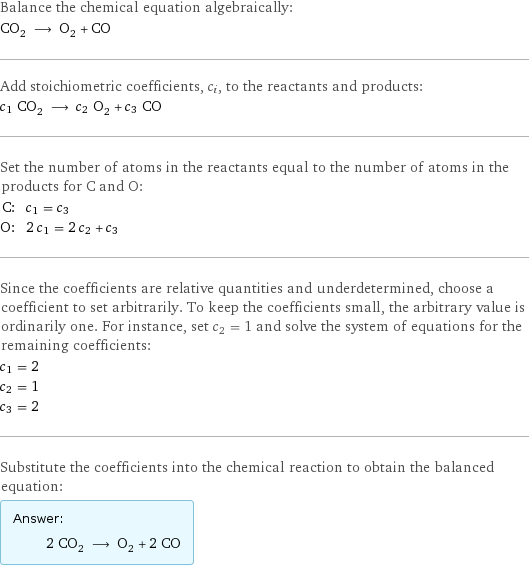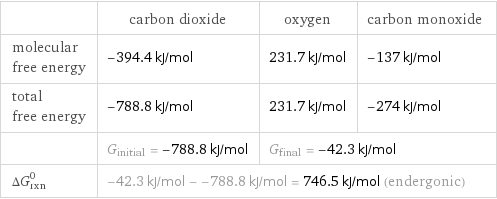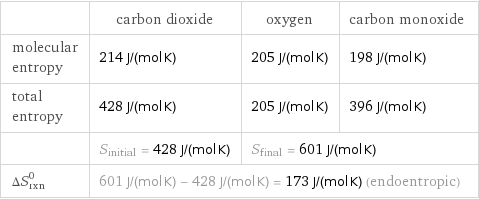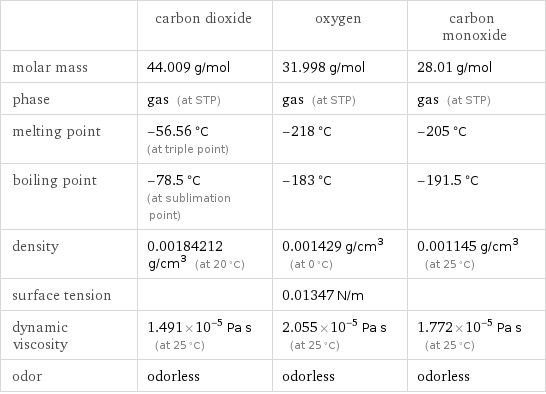Input interpretation

CO_2 carbon dioxide ⟶ O_2 oxygen + CO carbon monoxide
Balanced equation

Balance the chemical equation algebraically: CO_2 ⟶ O_2 + CO Add stoichiometric coefficients, c_i, to the reactants and products: c_1 CO_2 ⟶ c_2 O_2 + c_3 CO Set the number of atoms in the reactants equal to the number of atoms in the products for C and O: C: | c_1 = c_3 O: | 2 c_1 = 2 c_2 + c_3 Since the coefficients are relative quantities and underdetermined, choose a coefficient to set arbitrarily. To keep the coefficients small, the arbitrary value is ordinarily one. For instance, set c_2 = 1 and solve the system of equations for the remaining coefficients: c_1 = 2 c_2 = 1 c_3 = 2 Substitute the coefficients into the chemical reaction to obtain the balanced equation: Answer: | | 2 CO_2 ⟶ O_2 + 2 CO
Structures

⟶ +
Names

carbon dioxide ⟶ oxygen + carbon monoxide
Reaction thermodynamics
Enthalpy

| carbon dioxide | oxygen | carbon monoxide molecular enthalpy | -393.5 kJ/mol | 0 kJ/mol | -110.5 kJ/mol total enthalpy | -787 kJ/mol | 0 kJ/mol | -221 kJ/mol | H_initial = -787 kJ/mol | H_final = -221 kJ/mol | ΔH_rxn^0 | -221 kJ/mol - -787 kJ/mol = 566 kJ/mol (endothermic) | |
Gibbs free energy

| carbon dioxide | oxygen | carbon monoxide molecular free energy | -394.4 kJ/mol | 231.7 kJ/mol | -137 kJ/mol total free energy | -788.8 kJ/mol | 231.7 kJ/mol | -274 kJ/mol | G_initial = -788.8 kJ/mol | G_final = -42.3 kJ/mol | ΔG_rxn^0 | -42.3 kJ/mol - -788.8 kJ/mol = 746.5 kJ/mol (endergonic) | |
Entropy

| carbon dioxide | oxygen | carbon monoxide molecular entropy | 214 J/(mol K) | 205 J/(mol K) | 198 J/(mol K) total entropy | 428 J/(mol K) | 205 J/(mol K) | 396 J/(mol K) | S_initial = 428 J/(mol K) | S_final = 601 J/(mol K) | ΔS_rxn^0 | 601 J/(mol K) - 428 J/(mol K) = 173 J/(mol K) (endoentropic) | |
Equilibrium constant
![Construct the equilibrium constant, K, expression for: CO_2 ⟶ O_2 + CO Plan: • Balance the chemical equation. • Determine the stoichiometric numbers. • Assemble the activity expression for each chemical species. • Use the activity expressions to build the equilibrium constant expression. Write the balanced chemical equation: 2 CO_2 ⟶ O_2 + 2 CO Assign stoichiometric numbers, ν_i, using the stoichiometric coefficients, c_i, from the balanced chemical equation in the following manner: ν_i = -c_i for reactants and ν_i = c_i for products: chemical species | c_i | ν_i CO_2 | 2 | -2 O_2 | 1 | 1 CO | 2 | 2 Assemble the activity expressions accounting for the state of matter and ν_i: chemical species | c_i | ν_i | activity expression CO_2 | 2 | -2 | ([CO2])^(-2) O_2 | 1 | 1 | [O2] CO | 2 | 2 | ([CO])^2 The equilibrium constant symbol in the concentration basis is: K_c Mulitply the activity expressions to arrive at the K_c expression: Answer: | | K_c = ([CO2])^(-2) [O2] ([CO])^2 = ([O2] ([CO])^2)/([CO2])^2](../image_source/85062ce0ed2d01daeeddc2bd8e4102e6.png)
Construct the equilibrium constant, K, expression for: CO_2 ⟶ O_2 + CO Plan: • Balance the chemical equation. • Determine the stoichiometric numbers. • Assemble the activity expression for each chemical species. • Use the activity expressions to build the equilibrium constant expression. Write the balanced chemical equation: 2 CO_2 ⟶ O_2 + 2 CO Assign stoichiometric numbers, ν_i, using the stoichiometric coefficients, c_i, from the balanced chemical equation in the following manner: ν_i = -c_i for reactants and ν_i = c_i for products: chemical species | c_i | ν_i CO_2 | 2 | -2 O_2 | 1 | 1 CO | 2 | 2 Assemble the activity expressions accounting for the state of matter and ν_i: chemical species | c_i | ν_i | activity expression CO_2 | 2 | -2 | ([CO2])^(-2) O_2 | 1 | 1 | [O2] CO | 2 | 2 | ([CO])^2 The equilibrium constant symbol in the concentration basis is: K_c Mulitply the activity expressions to arrive at the K_c expression: Answer: | | K_c = ([CO2])^(-2) [O2] ([CO])^2 = ([O2] ([CO])^2)/([CO2])^2
Rate of reaction
![Construct the rate of reaction expression for: CO_2 ⟶ O_2 + CO Plan: • Balance the chemical equation. • Determine the stoichiometric numbers. • Assemble the rate term for each chemical species. • Write the rate of reaction expression. Write the balanced chemical equation: 2 CO_2 ⟶ O_2 + 2 CO Assign stoichiometric numbers, ν_i, using the stoichiometric coefficients, c_i, from the balanced chemical equation in the following manner: ν_i = -c_i for reactants and ν_i = c_i for products: chemical species | c_i | ν_i CO_2 | 2 | -2 O_2 | 1 | 1 CO | 2 | 2 The rate term for each chemical species, B_i, is 1/ν_i(Δ[B_i])/(Δt) where [B_i] is the amount concentration and t is time: chemical species | c_i | ν_i | rate term CO_2 | 2 | -2 | -1/2 (Δ[CO2])/(Δt) O_2 | 1 | 1 | (Δ[O2])/(Δt) CO | 2 | 2 | 1/2 (Δ[CO])/(Δt) (for infinitesimal rate of change, replace Δ with d) Set the rate terms equal to each other to arrive at the rate expression: Answer: | | rate = -1/2 (Δ[CO2])/(Δt) = (Δ[O2])/(Δt) = 1/2 (Δ[CO])/(Δt) (assuming constant volume and no accumulation of intermediates or side products)](../image_source/c30961d761fc8ec349f8873a7d99ac46.png)
Construct the rate of reaction expression for: CO_2 ⟶ O_2 + CO Plan: • Balance the chemical equation. • Determine the stoichiometric numbers. • Assemble the rate term for each chemical species. • Write the rate of reaction expression. Write the balanced chemical equation: 2 CO_2 ⟶ O_2 + 2 CO Assign stoichiometric numbers, ν_i, using the stoichiometric coefficients, c_i, from the balanced chemical equation in the following manner: ν_i = -c_i for reactants and ν_i = c_i for products: chemical species | c_i | ν_i CO_2 | 2 | -2 O_2 | 1 | 1 CO | 2 | 2 The rate term for each chemical species, B_i, is 1/ν_i(Δ[B_i])/(Δt) where [B_i] is the amount concentration and t is time: chemical species | c_i | ν_i | rate term CO_2 | 2 | -2 | -1/2 (Δ[CO2])/(Δt) O_2 | 1 | 1 | (Δ[O2])/(Δt) CO | 2 | 2 | 1/2 (Δ[CO])/(Δt) (for infinitesimal rate of change, replace Δ with d) Set the rate terms equal to each other to arrive at the rate expression: Answer: | | rate = -1/2 (Δ[CO2])/(Δt) = (Δ[O2])/(Δt) = 1/2 (Δ[CO])/(Δt) (assuming constant volume and no accumulation of intermediates or side products)
Chemical names and formulas

| carbon dioxide | oxygen | carbon monoxide formula | CO_2 | O_2 | CO name | carbon dioxide | oxygen | carbon monoxide IUPAC name | carbon dioxide | molecular oxygen | carbon monoxide
Substance properties

| carbon dioxide | oxygen | carbon monoxide molar mass | 44.009 g/mol | 31.998 g/mol | 28.01 g/mol phase | gas (at STP) | gas (at STP) | gas (at STP) melting point | -56.56 °C (at triple point) | -218 °C | -205 °C boiling point | -78.5 °C (at sublimation point) | -183 °C | -191.5 °C density | 0.00184212 g/cm^3 (at 20 °C) | 0.001429 g/cm^3 (at 0 °C) | 0.001145 g/cm^3 (at 25 °C) surface tension | | 0.01347 N/m | dynamic viscosity | 1.491×10^-5 Pa s (at 25 °C) | 2.055×10^-5 Pa s (at 25 °C) | 1.772×10^-5 Pa s (at 25 °C) odor | odorless | odorless | odorless
Units
